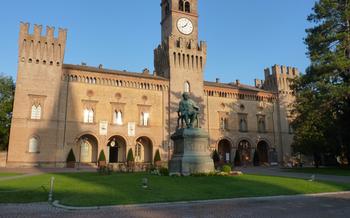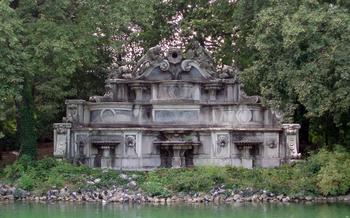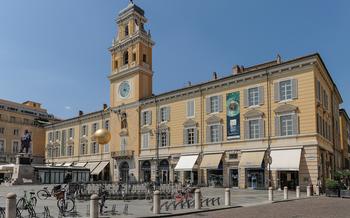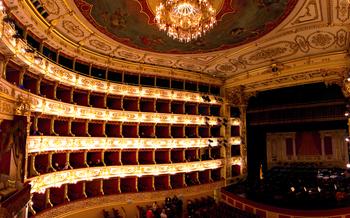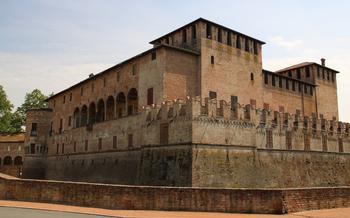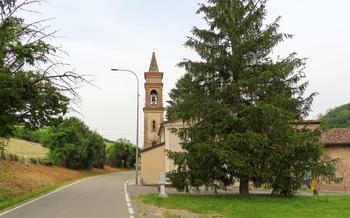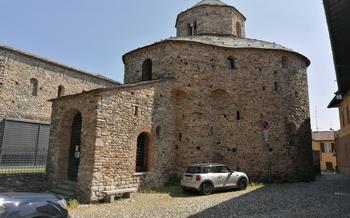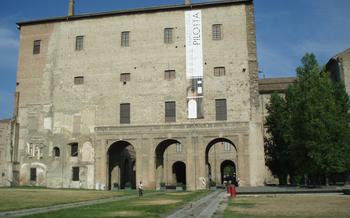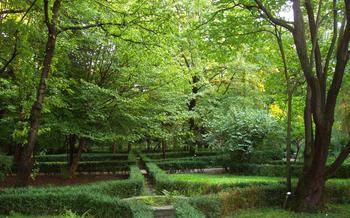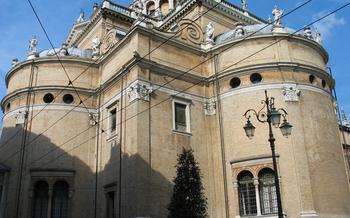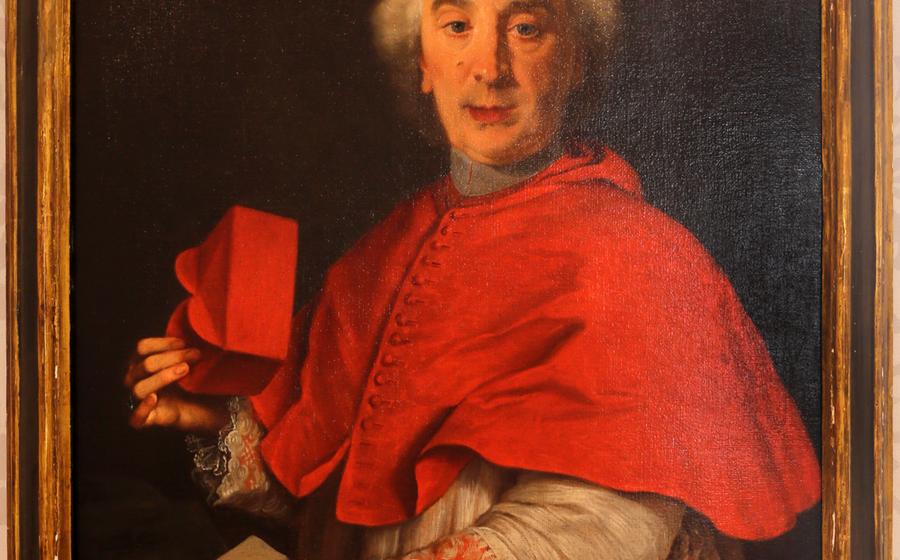
Labirinto della Masone
- Introduction
- History and Origin
- Design and Layout
- Getting There:
- Admission and Hours
- The Experience: Getting Lost in the Winding Paths
- Symbolism and Meaning
- The Center of the Labyrinth
- Events and Workshops
- Food and Drinks
- Nearby Attractions
- Photography and Social Media
- Insider Tip:
Introduction
Nestled in the heart of the Emilia-Romagna region, Parma, Italy, is a culinary paradise renowned for its world-class gastronomy, including the iconic Prosciutto di Parma and Parmigiano Reggiano cheese. However, beyond its culinary delights, Parma boasts a unique and intriguing attraction that beckons travelers seeking a mystical experience: the Labirinto della Masone, a labyrinth that is not just a puzzling maze but a symbol of self-discovery and reflection.
History and Origin
The Labirinto della Masone is the and bibliophile. Ricci was inspired by the labyrinth depicted in the short story "The Garden of Forking Paths" by Jorge Luis Borges, a work that explores the nature of time, infinity, and the interconnectedness of all things.
In 1981, Ricci purchased a parcel of land near his beloved city of Parma, envisioning the creation of a labyrinth that would both honor the written word and offer visitors a unique and immersive experience. He commissioned the design to Pier Carlo Bontempi, an architect from Milan, who created an elaborate and intricate layout inspired by classical and medieval labyrinths.
Over the course of ten years, the labyrinth was meticulously constructed using more than 200,000 bamboo plants, each carefully trimmed and shaped to create the towering hedges that define the labyrinth's paths. The result is a captivating and awe-inspiring work of art, a testament to Ricci's passion for books, beauty, and the power of imagination.
Design and Layout
At the heart of the Labirinto della Masone lies an intricate masterpiece of design and geometry. Franco Maria Ricci, the visionary behind this creation, drew inspiration from ancient labyrinths, particularly the one at Chartres Cathedral in France. The labyrinth extends over an area of eight hectares, comprising lush green hedges that form a complex network of winding paths. These paths, carefully laid out in a symmetrical pattern, lead visitors on a journey of discovery and self-reflection.
The labyrinth's design is characterized by a series of concentric circles, representing the cyclical nature of life and the interconnectedness of all things. These circles are further divided into quadrants, each with its own unique path. The complexity of the layout ensures that visitors can get lost in the maze-like structure, creating a sense of disorientation and encouraging introspection.
Beyond its physical form, the Labirinto della Masone also holds symbolic meaning. The labyrinth serves as a metaphor for the journey of life, with its twists and turns representing challenges, obstacles, and choices that we encounter along the way. The winding paths symbolize the search for truth, knowledge, and enlightenment, inviting visitors to embark on a transformative experience.
Getting There:
Reaching the Labirinto della Masone from Parma city center is a breeze. If you prefer the convenience of public transportation, hop on bus number 21 from the main bus station and get off at the "Labirinto" stop. From there, it's just a short walk to the entrance. For those who enjoy a leisurely bike ride, cycling is an excellent option. Follow the scenic bike path along the Parma River, and you'll find yourself at the labyrinth's doorstep in no time. Guided tours are also available, providing a knowledgeable guide to lead you through the labyrinth and share its fascinating history and symbolism. Whether you choose to go it alone or join a guided group, the journey to the Labirinto della Masone is an adventure in itself.
Admission and Hours
Admission to the Labirinto della Masone is charged, and the ticket price includes a guided tour in Italian or English. Visitors can also choose to explore the labyrinth on their own without a guide. Discounts are available for students, seniors, and families. The labyrinth is open to the public every day except Mondays. Operating hours vary depending on the season, with extended hours during the summer months. Visitors are advised to check the official website for the most up-to-date information on admission fees and operating hours.
The Experience: Getting Lost in the Winding Paths
Stepping into the Labirinto della Masone is like embarking on a journey into the unknown. The towering hedges create a sense of mystery and seclusion, enveloping visitors in a world of verdant green. As you wander through the labyrinth, the paths twist and turn, leading you deeper into its intricate design. The feeling of disorientation is both exhilarating and unsettling, challenging your sense of direction and inviting you to surrender to the experience.
With each turn, the labyrinth reveals new perspectives and hidden corners. The rustling of leaves and the distant sound of birdsong add to the surreal atmosphere, creating a sense of being both alone and connected to the natural world. As you progress through the labyrinth, the challenge of finding the way out becomes a metaphor for life's own journey, reminding us that sometimes the most rewarding paths are the ones that lead us into the unknown.
Symbolism and Meaning
The Labirinto della Masone is not just a physical structure; it carries deep symbolic and metaphysical meanings. It represents a journey of self-discovery, reflection, and transformation, mirroring the inner workings of the human mind. The labyrinth's winding paths symbolize the complexities and challenges of life, while the act of navigating through it represents the individual's quest for enlightenment and self-knowledge.
The connection between the labyrinth and the world of literature is particularly profound, especially in relation to the works of Jorge Luis Borges, a renowned Argentine writer and philosopher. Borges was fascinated by labyrinths and often incorporated them into his stories and essays. His writings explored the themes of identity, memory, and infinity, which resonate deeply with the symbolic significance of the labyrinth. By delving into the depths of the labyrinth, visitors can embark on a literary pilgrimage, experiencing a tangible connection to Borges' labyrinthine world.
The Center of the Labyrinth
Upon reaching the center of the labyrinth, visitors are greeted by a striking sight—the "Mirror of Time." This unique artwork, created by contemporary artist Arnaldo Pomodoro, consists of a large bronze mirror that reflects the sky and the surrounding landscape. The mirror's polished surface invites visitors to contemplate the passage of time and their place within its infinite flow. It serves as a poignant reminder of the transience of life and the eternal nature of the universe, echoing the labyrinth's themes of self-discovery and reflection. The Mirror of Time is not just an aesthetic centerpiece but also a profound symbol that encourages visitors to introspect and ponder the deeper meanings of their journey through the labyrinth.
Events and Workshops
Throughout the year, the Labirinto della Masone hosts a variety of special events, workshops, and exhibitions that enrich the visitor experience. These events provide an opportunity to delve deeper into the history, symbolism, and cultural significance of the labyrinth.
Guided tours are available for those who wish to learn more about the creation and design of the labyrinth. Expert guides lead visitors through the winding paths, explaining the symbolism embedded within the layout and sharing anecdotes about its construction.
Educational programs and workshops are also offered, particularly for students and groups. These programs focus on the themes of labyrinths in literature, art, and mythology. Participants can engage in discussions, creative activities, and hands-on experiences that foster a deeper understanding of the labyrinth's multifaceted meanings.
Special exhibitions are periodically held at the labyrinth, showcasing works of art, photography, and installations that explore the labyrinth's connection to various creative disciplines. These exhibitions offer visitors a unique perspective on the labyrinth, encouraging them to see it as a canvas for artistic expression.
Food and Drinks
While exploring the Labirinto della Masone, visitors can indulge in a variety of food and beverage options to enhance their experience. Within the labyrinth grounds, a small café offers a selection of light refreshments, including sandwiches, salads, and homemade pastries. Visitors can enjoy their snacks while taking a break from navigating the labyrinth's paths and soaking in the serene atmosphere.
For a more substantial meal, it is recommended to venture outside the labyrinth and explore the culinary delights of Parma. The city center is home to numerous restaurants, trattorias, and cafes, offering a wide range of traditional Italian cuisine. From artisanal pasta dishes to cured meats and local cheeses, visitors can savor the flavors of Parma's renowned food scene.
To fully immerse yourself in the local culture, consider combining a visit to the Labirinto della Masone with a food tour or cooking class. These experiences allow visitors to learn about Parma's culinary traditions, visit local markets, and indulge in hands-on cooking sessions to create their own Italian masterpieces.
Nearby Attractions
Parma offers a wealth of other attractions to explore, both within the city center and its surrounding area. The historic center of Parma is a treasure trove of architectural wonders, with the majestic Duomo Cathedral standing as a testament to the city's rich religious heritage. The Teatro Regio opera house, with its opulent interior and world-renowned acoustics, is a must-visit for opera enthusiasts.
Just a short walk from the labyrinth, visitors can immerse themselves in the vibrant culinary scene of Parma. The city is renowned for its production of world-class prosciutto, Parmigiano Reggiano cheese, and balsamic vinegar. A visit to Parma is not complete without savoring these local delicacies at one of the many traditional trattorias or restaurants in the city.
For those seeking a more active experience, the surrounding countryside offers a range of outdoor activities. The Taro River, which flows through the province of Parma, provides opportunities for kayaking, rafting, and fishing. The nearby Apennines Mountains offer scenic hiking trails, mountain biking routes, and breathtaking views of the surrounding landscape.
By combining a visit to the Labirinto della Masone with other attractions in Parma, visitors can create a well-rounded and memorable travel experience that encompasses history, culture, gastronomy, and nature.
Photography and Social Media
With its visually striking design and enchanting atmosphere, the Labirinto della Masone offers countless opportunities for photography enthusiasts. Capture the winding paths, towering hedges, and intricate patterns that make up this unique labyrinth. Share your experiences on social media using hashtags like #LabirintodellaMasone, #Parma, and #Labyrinth to connect with fellow travelers and labyrinth enthusiasts worldwide. Embrace the chance to create one-of-a-kind images that will transport your followers into the heart of this enigmatic maze.
Insider Tip:
To fully immerse yourself in the magic of the Labirinto della Masone, plan your visit for the early hours of the morning or the late afternoon when the crowds are fewer, and the atmosphere is more serene. Take your time to wander through the winding paths, savor the tranquility of the garden, and contemplate the symbolism embedded within the labyrinth's design.
Combine your visit to the Labirinto della Masone with a culinary adventure in Parma. Embark on a food tour to discover the city's renowned culinary treasures, such as Prosciutto di Parma, Parmigiano-Reggiano cheese, and the traditional dish of Tortelli d'Erbetta. Alternatively, participate in a cooking class to learn the art of preparing authentic Italian cuisine using fresh, local ingredients. This immersive experience will provide a deeper understanding of Parma's rich culinary heritage and allow you to savor the flavors that make this region so special.
